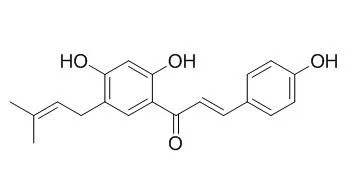| In vitro: |
| Evid Based Complement Alternat Med. 2014;2014:958937. | | Comparison of the Inhibitory Potential of Bavachalcone and Corylin against UDP-Glucuronosyltransferases.[Pubmed: 24829606] | Bavachalcone and corylin are two major bioactive compounds isolated from Psoralea corylifolia L., which has been widely used as traditional Chinese medicine for many years. As two antibiotic or anticancer drugs, Bavachalcone and corylin are used in combination with other drugs; thus it is necessary to evaluate potential pharmacokinetic herb-drug interactions (HDI) of the two bioactive compounds.
METHODS AND RESULTS:
The aim of the present study was to compare the effects of liver UDP-glucuronosyltransferase (UGT) 1A1, UGT1A3, UGT1A7, UGT1A8, UGT 1A10, and UGT2B4 inhibited by Bavachalcone and corylin. 4-Methylumbelliferone (4-MU) was used as a nonspecific "probe" substrate. Bavachalcone had stronger inhibition on UGT1A1 and UGT1A7 than corylin which did not inhibit UGT1A1, UGT1A3, UGT1A7, UGT1A8, UGT1A10, and UGT2B4. Data fitting using Dixon and Lineweaver-Burk plots demonstrated the noncompetitive inhibition of Bavachalcone against UGT1A1 and UGT1A7-mediated 4-MU glucuronidation reaction. The values of inhibition kinetic parameters (Ki) were 5.41 μ M and 4.51 μ M for UGT1A1 and UGT1A7, respectively.
CONCLUSIONS:
The results of present study suggested that there was a possibility of UGT1A1 and UGT1A7 inhibition-based herb-drug interaction associated with Bavachalcone and provided the basis for further in vivo studies to investigate the HDI potential between Bavachalcone and UGT substrates. | | Biochem Pharmacol. 2008 Jun 1;75(11):2175-82. | | Bavachalcone inhibits osteoclast differentiation through suppression of NFATc1 induction by RANKL.[Pubmed: 18433733] | Osteoclasts are cells that have a specialized role for bone resorption and are responsible for many bone diseases such as osteoporosis. As herbal products are invaluable sources in discovery of compounds for new therapies, we sought to identify compounds efficacious in suppressing osteoclastogenesis from medicinal plants that have been implicated for treatment of osteoporotic conditions.
METHODS AND RESULTS:
Bavachalcone was isolated from Psoralea corylifolia, and its effects on osteoclast differentiation were evaluated with primary cultures of osteoclast precursor cells. In addition, the molecular mechanism of action was investigated. Bavachalcone inhibited osteoclast formation from precursor cells with the IC(50) of approximately 1.5 microg ml(-1). The activation of MEK, ERK, and Akt by receptor activator of nuclear factor kappaB ligand (RANKL), the osteoclast differentiation factor, was prominently reduced in the presence of Bavachalcone. The induction of c-Fos and NFATc1, key transcription factors for osteoclastogenesis, by RANKL was also suppressed by Bavachalcone. In conclusion, Bavachalcone inhibits osteoclastogenesis by interfering with the ERK and Akt signaling pathways and the induction of c-Fos and NFATc1 during differentiation.
CONCLUSIONS:
Our results suggest that Bavachalcone may be useful as a therapeutic drug for bone resorption-associated diseases. |
|






 Cell. 2018 Jan 11;172(1-2):249-261.e12. doi: 10.1016/j.cell.2017.12.019.IF=36.216(2019)
Cell. 2018 Jan 11;172(1-2):249-261.e12. doi: 10.1016/j.cell.2017.12.019.IF=36.216(2019) Cell Metab. 2020 Mar 3;31(3):534-548.e5. doi: 10.1016/j.cmet.2020.01.002.IF=22.415(2019)
Cell Metab. 2020 Mar 3;31(3):534-548.e5. doi: 10.1016/j.cmet.2020.01.002.IF=22.415(2019) Mol Cell. 2017 Nov 16;68(4):673-685.e6. doi: 10.1016/j.molcel.2017.10.022.IF=14.548(2019)
Mol Cell. 2017 Nov 16;68(4):673-685.e6. doi: 10.1016/j.molcel.2017.10.022.IF=14.548(2019)